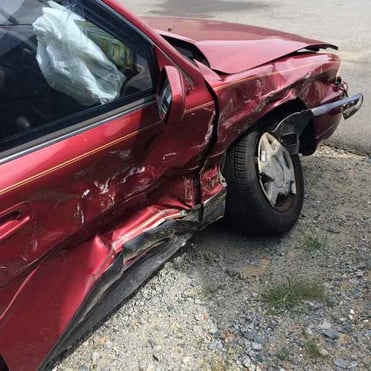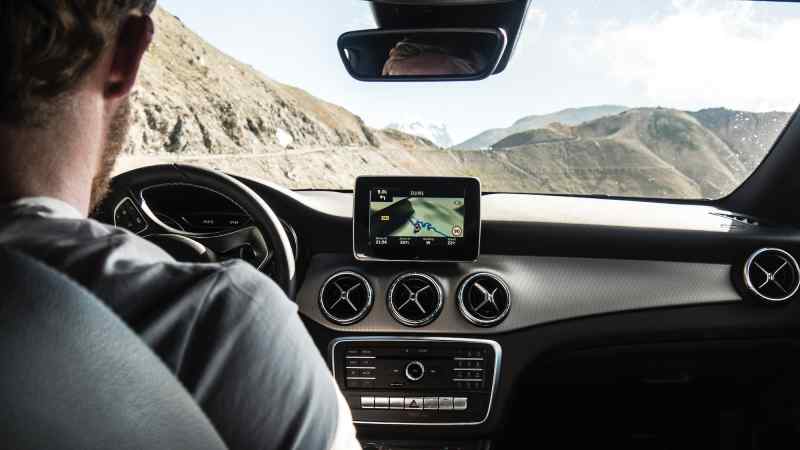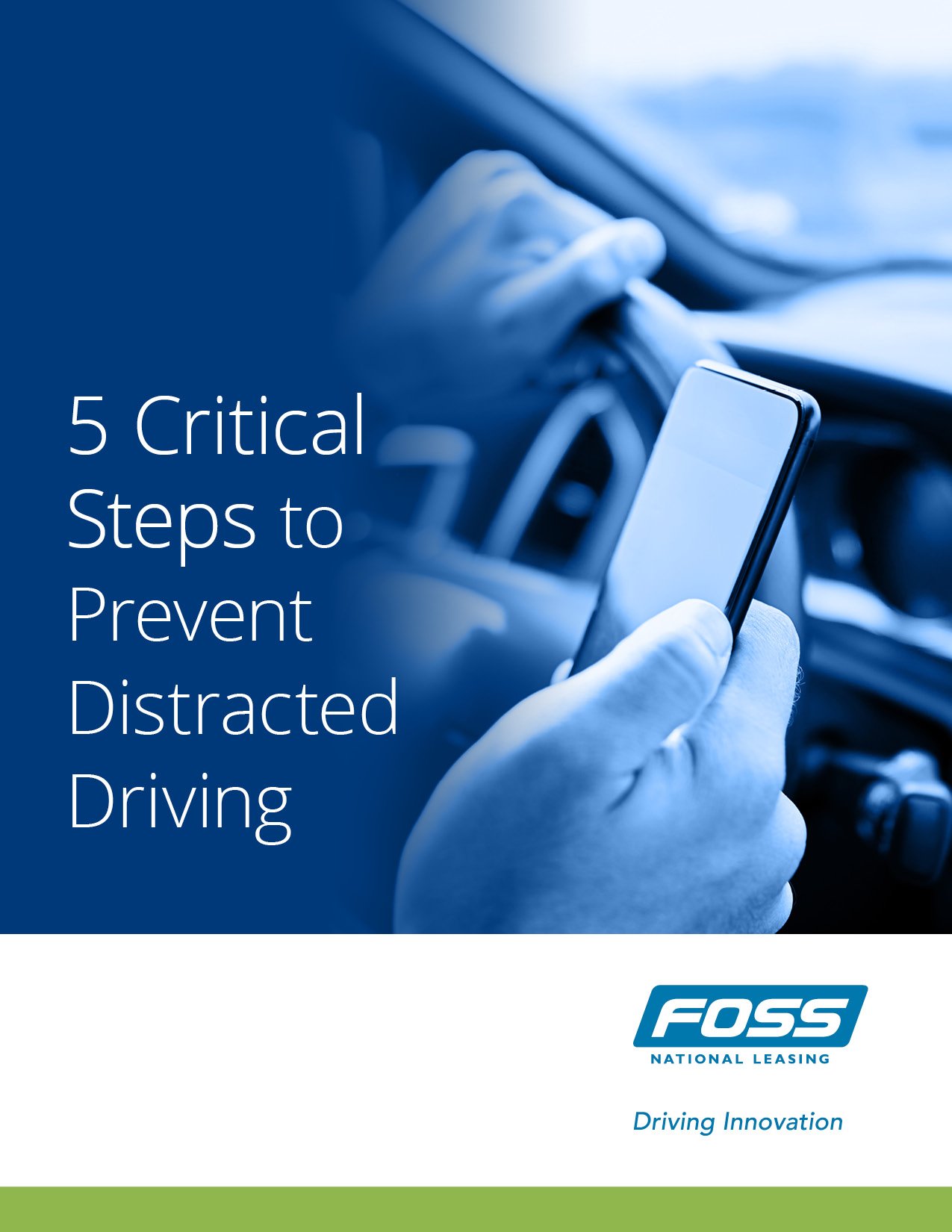
This article is part one of a two-part interview series on critical driver safety issues. Check out part two here.
Distracted driving is a huge issue—especially for fleets who operate many vehicles every day.
And unfortunately, it’s increasingly common.
So what can you do about it?
To get some real insights into how to prevent distracted driving, we contacted Charles Shrybman, director of research for Young Drivers of Canada, and affiliate member of the Transportation Research Board.
In this interview, Charles shares critical points on distracted driving, including tips on how to improve your fleet safety program.
Distracted Driving Facts: Interview with Charles Shrybman of Young Drivers of Canada
Let’s start with the basics. What is distracted driving, exactly?
The evidence is that driving while distracted is the single biggest factor in vehicle collisions. And vehicle collisions are the leading cause of workplace fatalities and injuries. Dealing with distracted driving is a priority for anyone managing a fleet and/or the employees who drive company vehicles.
Driving is a very complex skill. Even a short drive requires a variety of mental processes, from short term and mid term memory, to visual scanning, hand-eye coordination, assessment of speed and distance, and risk assessment.
Distracted driving is engaging in any secondary task that isn’t related to driving safely. There are three different types:
- Cognitive, for example during a call when you're trying to solve a problem or make arrangements.
- Visual, which is any time you take your eyes off the road, including glancing at scenery and signage.
- Manual, when you take one or both hands off the wheel to do something that isn’t related to safe driving.
Some distractions, such as texting, involve all three forms of distraction. That's one of the reasons why it's so dangerous.
What are the indirect and direct costs associated with distracted driving incidents for business owners or fleets?

There’s the obvious cost of repairing and replacing vehicles, whether that's done directly in the case of a self-insured fleet or indirectly due to increased insurance costs.
But what really affects a lot of fleets are the human costs. One thing any safety committee should be aware of is that collision injuries are twice as likely to result in a fatality or permanent injury than other workplace accidents.
Indirect costs would include lost productivity, disruptions in customer service, potential overtime costs if somebody has to cover for a missing driver due to a collision injury, and potential training costs if someone is off for extended period of time, or is even unable to continue working.
Further, in the US and Canada, fleet insurance rates have been increasing for the past five years. It's believed that the major reason is distracted driving. There are also potential liabilities for some companies if their vehicles are in serious collisions.
Finally, this can have an effect on the company's reputation, depending on the collision and what the driver is doing. For example, for companies in the safety field, if a driver ends up injuring somebody because they were texting, it may damage the company's reputation.
What are some common rationalizations people make when driving distracted? How do they maintain a state of denial about their own dangerous driving habits?
The number one thing I hear is: “I'm doing it safely. I'm paying attention.” If you survey a hundred drivers and you ask them to rate themselves on how they are as a driver, the large majority (85 to 90 percent) will rate themselves as above average.
So drivers believe they can handle distractions. The fact that we get away with things the vast majority of the time doesn’t mean we haven’t been increasing the risk to ourselves and others. The problem is, there's a lot of evidence that we’re not aware of what we're not aware of. There's a phenomenon called inattentional blindness. People don't actually perceive all the information that their senses send to their brains. The brain simply can’t handle it all.
You can check out Invisible Gorilla to learn more about how inattentional blindness works.
The other common explanation that I've heard is: “It's only going to be for a few seconds.” My first comment on that is, typically it's longer than you think. If a message comes in on your phone and you grab it to look at who sent the message, that’s probably taken you four or five seconds. At 80 km/h, you travel the length of a football field in five seconds. So if you're looking at your phone, you're travelling it blind.

The other problem is, our vehicles now have screens with all sorts of information on them. And believe it or not, I’ve heard drivers say, “If the manufacturer built it into the vehicle it must be safe. It's not like I'm handling my phone.” But the evidence says that's not the case.
Manufacturers didn't install navigation screens for safety purposes. They’re a convenience feature that’s used to sell vehicles. And research shows, taking your eyes off the road to do something on the screen can be quite dangerous if it takes too long or takes repeated glances to complete an operation.
This leads to one other comment on this: voice-to-text. There is an increasing belief, according to surveys that have been done, that voice-to-text is safe. But distracted driving research done out of the University of Texas actually compared distraction between manually texting and voice-to-text messaging. And they found that, overall there was no significant difference in safety. Driving response times were significantly delayed no matter which text message type was used.
They also reported that drivers felt less safe when they were texting but felt more safe when using the voice-to-text application, even though driving performance suffered equally with both methods.
(Related post: What Does Texting While Driving Really Cost Your Fleet?)
What are some of the tactics business owners can implement to eliminate or minimize distracted driving?
We would recommend that companies completely ban texting and emailing while drivers are on the road. The National Highway Traffic Safety Administration, amongst others, talks about odds ratios. If the odds ratio of being in a collision under normal driving circumstances is 1.0, it rises to around 4.0 when a driver dials a cell phone. The Second Strategic Highway Research Program Naturalistic Driving Study (SHRP 2) naturalistic driving study monitored over 3,500 drivers, and discovered the odds ratio for texting was 6.1.
We also recommend companies ensure all employees have an auto reply set-up on their phones. That way, if they're driving and someone emails or messages them, it sends an auto-reply stating that they're driving and will answer as soon as it's safe.
The other thing is, employees and management in the office should check a driver’s location and schedule before phoning them. If they’re driving, you can then figure out another time when they can talk where it will be safe.
Does the installation of telematics, dash cams or the use of smartphone apps impact driving behavior?

Telematics and dash cams can improve driver behaviour, but the effect is normally short-term. We see an improvement for a while and then things tend to slip back to where they were.
There needs to be an active monitoring program if they are to have any long-term benefits. And what many companies are finding, is in order to get a buy-in from employees, they need to use the dash cam footage to give rewards—not just penalties.
You could also do what we call “self selection”—meaning, the first drivers to get telematics and dash cams in their vehicles are those who have had some form of a traffic violation or other incident, or otherwise have poor driving habits.
How often do companies need to have driver training sessions to have a meaningful impact on distracted driving?
One size doesn’t fit all. What we propose would be an initial class and in-car session, as part of a distracted driving prevention program. And it's important that an in-car session is included so we can see how the drivers actually handle the car on the road. There can be important discrepancies between what is said and what is done. In-car evaluations are key to sorting this out.
At Young Drivers, we’re working on grouping drivers into three categories: green, yellow and red. After that initial session, we classify the ones that have good driving habits as green. This group may only need to have a review every two or three years. If they're yellow, we would recommend they have training every year until they get to green. And if they’re red, we would recommend some additional training in the short-term, until they at least meet the yellow level.
Are there statistics that equate driver safety training to a reduction in distracted driving and lower fleet operating costs?
There aren’t a lot of good statistics on that with a couple of notable exceptions. There are actually good statistics that show that a certain type of training actually increases crashes.
Here’s an example: In Norway, every novice driver was required to take a course for driving on slippery roads until the end of the 1980s. They don’t do that anymore because they had a researcher looking for the results, and they found that the people who took that course ended up having more crashes on slippery roads in the following years.

Finland also had a short course on handling skids, with the same result. Norway developed a course for truck drivers with the same result.
A meta analysis was done that looked at six such programs, and found that every course that focused on “skills training” increased crashes. The worst was one specially developed for ambulance drivers which increased their crash rate by 45%.
This led the International Road Federation Road Safety Committee to declare that training programs aimed at enhancing the skills to regain control in emergency situations should not be included in basic driver education, or in advanced driver training programs. The evidence is that these training programs tend to lead to overconfidence.
They actually did a test where they divided a group into two sub-groups. Both groups drove out on a slippery area, but only one group was trained on how to handle the skids. They brought them back one week later and they found no difference in the performance of the two groups.
However, in the follow-up survey done when they brought them back, the group that had training on handling the skids presented themselves as more prepared to handle them. So, it only took a week for them to lose what they had learned.
There are some stats that training drivers to be more insightful and better calibrated does lead to less crashes. A well calibrated driver is someone who has a good understanding of the risk out there, and a good assessment of their own abilities to handle situations.
One of the things we include in our training is a form of evasive maneuvers. What we're showing drivers is how difficult it is to handle a car in an emergency, so they have a better appreciation of what they can and can't do.
Now, I do have a stat on a fleet that uses our approach to defensive driving and saves money. It’s our own fleet. We have about 300 vehicles in our Young Drivers’ fleet. And currently in the city of Toronto, to get insurance as a driving instructor, you’ll pay over $6,000 a year on average. Most new instructors pay $9,000 to $11,000.
The insurance industry has been following our fleet for more than 40 years and they're charging us under $2,000. So, I would say our own fleet is an example that our approach works.
(Related post: How Can a Fleet Safety Program Help You Save Money?)
What are some methods for educating each age demographic of drivers about driving distracted?
The SHRP 2 study looked at distracted driving. Teenagers and young adult drivers, aged 21 to 29, as well as drivers 65 and over, were more adversely affected by it than middle aged drivers. The study also made a point of stating that visual-manual tasks—texting, e-mailing, browsing your phone, playing with the navigation system—adversely affected all ages.

This type of evidence has led to various jurisdictions in the US to ban new drivers from all cell phone calls, including hands-free. When you're dialing a cell phone, you're increasing your crash risk by four times. But the amount of time you spend dialing the phone is small compared to the amount of time you spend talking on a phone.
So it’s a matter of how dangerous the activity is, and how much time you spend doing it. Senior drivers tend to engage less in some of these distracting activities.
The research also found that drivers were engaged in some form of distraction nearly 52 percent of the time. And that distraction that was visible on camera was a factor in over sixty percent of collisions.
Any final thoughts to share with fleets about distracted driving?
Firstly, no one should underestimate the danger of distracted driving. The fact that people get away with it more than 99.99% of the time doesn’t mean that it won’t catch up to them at some point.
Secondly, it’s a fact that it’s not a practical possibility to eliminate all distracted driving. But this shouldn’t be taken as an excuse for not taking measures to eliminate the most dangerous distractions, while reducing others.
Some suggestions to do that are:
- Mandate that drivers avoid all texting, emailing and manual use of the phone while driving.
- Develop a checklist of things drivers must take care of before they start their vehicles. For example, checking their schedules and planning their routes. This helps eliminate and reduce distractions while driving.
- Guide drivers on assessing their surroundings while driving. For example, if they choose to drink coffee or water while driving or need to adjust some settings, have them make sure there are no other vehicles nearby.
- Train drivers to keep extra space in front of and around their vehicles. This will give them more time to refocus their attention after they’ve been momentarily distracted. It can provide them with an out if they’re a little late noticing a problem.
Next Step
Download our guide—5 Critical Steps to Prevent Distracted Driving—to learn the 5 actions every fleet manager should take to prevent distracted driving.
Get to Know the Author
Ryan joined the Foss National Leasing team in 2014. Though the son of our president, no special treatment is at play here! He really is a chip off the old block; Ryan is a hard worker, and in fact was the recipient of the 2016 Employee of the Year award. Starting in our Operations department, he received a promotion shortly thereafter to the Client Service department, and most recently was promoted to the Sales department. As a Sales Executive, Ryan is excited to work with small businesses, helping them find solutions to better manage and organize their commercial fleets. Outside of the office, Ryan enjoys skiing, cycling and staying active.
Meet our team






